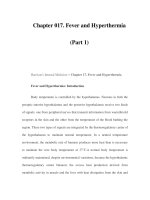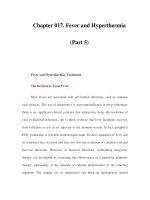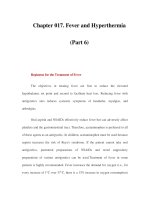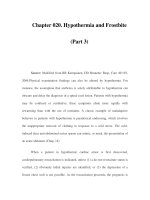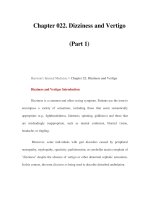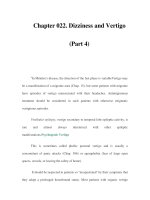Chapter 035. Hypoxia and Cyanosis (Part 5) doc
Bạn đang xem bản rút gọn của tài liệu. Xem và tải ngay bản đầy đủ của tài liệu tại đây (12.82 KB, 5 trang )
Chapter 035. Hypoxia and Cyanosis
(Part 5)
PERIPHERAL CYANOSIS
Probably the most common cause of peripheral cyanosis is the normal
vasoconstriction resulting from exposure to cold air or water. When cardiac output
is reduced, cutaneous vasoconstriction occurs as a compensatory mechanism so
that blood is diverted from the skin to more vital areas such as the central nervous
system and heart, and cyanosis of the extremities may result even though the
arterial blood is normally saturated.
Arterial obstruction to an extremity, as with an embolus, or arteriolar
constriction, as in cold-induced vasospasm (Raynaud's phenomenon, Chap. 243),
generally results in pallor and coldness, and there may be associated cyanosis.
Venous obstruction, as in thrombophlebitis, dilates the subpapillary venous
plexuses and thereby intensifies cyanosis.
Approach to the Patient: Cyanosis
Certain features are important in arriving at the cause of cyanosis:
1. It is important to ascertain the time of onset of cyanosis. Cyanosis
present since birth or infancy is usually due to congenital heart disease.
2. Central and peripheral cyanosis must be differentiated. Evidence
of disorders of the respiratory or cardiovascular systems are helpful.
Massage or gentle warming of a cyanotic extremity will increase peripheral
blood flow and abolish peripheral, but not central, cyanosis.
3. The presence or absence of clubbing of the digits (see below)
should be ascertained. The combination of cyanosis and clubbing is
frequent in patients with congenital heart disease and right-to-left shunting,
and is seen occasionally in patients with pulmonary disease such as lung
abscess or pulmonary arteriovenous fistulae. In contrast, peripheral
cyanosis or acutely developing central cyanosis is not associated with
clubbed digits.
4. Pa
O2
and Sa
O2
should be determined, and in patients with cyanosis
in whom the mechanism is obscure, spectroscopic examination of the blood
performed to look for abnormal types of hemoglobin (critical in the
differential diagnosis of cyanosis).
CLUBBING
The selective bullous enlargement of the distal segments of the fingers and
toes due to proliferation of connective tissue, particularly on the dorsal surface, is
termed clubbing; there is also increased sponginess of the soft tissue at the base of
the nail. Clubbing may be hereditary, idiopathic, or acquired and associated with a
variety of disorders, including cyanotic congenital heart disease (see above),
infective endocarditis, and a variety of pulmonary conditions (among them
primary and metastatic lung cancer, bronchiectasis, lung abscess, cystic fibrosis,
and mesothelioma), as well as with some gastrointestinal diseases (including
inflammatory bowel disease and hepatic cirrhosis). In some instances it is
occupational, e.g., in jackhammer operators.
Clubbing in patients with primary and metastatic lung cancer,
mesothelioma, bronchiectasis, and hepatic cirrhosis may be associated with
hypertrophic osteoarthropathy. In this condition, the subperiosteal formation of
new bone in the distal diaphyses of the long bones of the extremities causes pain
and symmetric arthritis-like changes in the shoulders, knees, ankles, wrists, and
elbows. The diagnosis of hypertrophic osteoarthropathy may be confirmed by
bone radiographs. Although the mechanism of clubbing is unclear, it appears to be
secondary to a humoral substance that causes dilation of the vessels of the
fingertip.
FURTHER READINGS
Fawcett RS et al: Nail abnormalities: Clues to systemic disease. Am Fam
Physician 69:1417, 2004 [PMID: 15053406]
Giordano FJ: Oxygen, oxidative stress, hypoxia, and heart failure. J Clin
Invest 115:500, 2005 [PMID: 15765131]
Griffey RT et al: Cyanosis. J Emerg Med 18:369, 2000 [PMID: 10729678]
Hackett PH, Roach RC: Current concepts: High altitude illness. N Engl J
Med 345:107, 2001 [PMID: 11450659]
Levy MM: Pathophysiology of oxygen delivery in respiratory failure. Chest
128(Suppl 2):547S, 2005
Michiels C: Physiological and pathological responses to hypoxia. Am J
Pathol 164:1875, 2004 [PMID: 15161623]
Tsai BMet al: Hypoxic pulmonary vasoconstriction in cardiothoracic
surgery: Basic mechanisms to potential therapies. Ann Thorac Surg 78:360, 2004
[PMID: 15223473]

